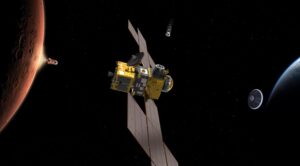Mars sample return mission plans begin to take shape

WASHINGTON — While neither NASA nor the European Space Agency has yet to give formal approval, or funding, for missions to return samples from Mars, both agencies are taking steps to refine plans for what those missions will be.
Those plans, discussed at a Mars science conference and working group meeting last week, would involve two launches in 2026 to send spacecraft to fetch samples collected by NASA’s Mars 2020 rover and return them to Earth in 2031.
NASA and ESA officials signed a statement of intent in April 2018 to study cooperation on a series, or “campaign,” of Mars sample return missions that follow a “lean” sample return architecture announced by NASA in August 2017. Under the proposed cooperation, NASA would provide a Mars lander mission, with a European-built rover, that would grab the samples collected by Mars 2020 and place them into a Mars ascent vehicle, a small rocket that would launch them into Mars orbit. An Earth return orbiter, built by ESA, would collect the sample container and return it to Earth.
That remains the overall plan, Jim Watzin, director of NASA’s Mars Exploration Program, said in a July 26 presentation at a meeting of the Mars Exploration Program Analysis Group (MEPAG) in Pasadena, California. “We want to pull this plan together and present it to the decision authorities for a decision by the end of the 2019 timeframe,” he said.
The plan as it currently exists, and as he presented at the MEPAG meeting, calls for two launches in 2026. The first, in the summer, would be the NASA lander, followed in the fall by the ESA orbiter. Both would take non-standard trajectories to get to Mars, with the orbiter getting there in about a year with the assistance of solar electric propulsion, while the lander would take two years to get to Mars.
While launch windows for Mars open for several weeks every 26 months, Watzin said not every opportunity is feasible for the pair of Mars sample return missions. “Propulsion demands are enormous,” he said. “There’s a couple opportunities where the energetics are manageable for a reasonable budget and reasonable technology. The rest of the opportunities require the invention of new things.”
If both missions launch in 2026, the lander will touch down near the Mars 2020 site in 2028 and send out a rover to collect samples. Most of those samples will be in tubes left behing on the ground by the Mars 2020 rover, but Watzin said there is the option for Mars 2020, if it is still functioning, to deliver some samples directly to the lander in the event something goes wrong with the fetch rover. “I think we’ve conquered one of the big worries, and we’ve put robustness into retrieval of the tubes,” he said.
The lander’s ascent vehicle will then place the sample container into orbit, where the orbiter collects it and places it into an Earth entry vehicle. The Mars orbiter then returns to Earth using electric propulsion, arriving in 2031. The entry vehicle will reenter and crash-land in a test range in Utah.
While the proposed campaign of missions has yet to win formal approval by NASA and ESA, both agencies are moving ahead. Watzin said NASA held an acquisition strategy meeting July 12 about the Mars sample return campaign. At the end of the meeting, agency leadership gave Watzin approval to move into budget development for NASA’s contributions to the mission and continue cooperation with ESA. “It was a very positive, very important milestone gate for us to get through,” he said.
ESA is also moving forward with its contributions. It released July 23 an “invitation to tender,” a form of request for proposals, to industry to build the orbiter, based on recently completed studies of the orbiter’s design. Watzin said ESA is going forward with the call for proposals even though ESA’s member states won’t decide whether to fund the program until the Space19+ ministerial meeting in late November.
“I’m really proud and impressed with how aggressively and seriously ESA is stepping up, trying to make this a reality,” he said. ‘Their intent is to use the time between now and when they hope to get approval from the ministerial to do that solicitation, do an evaluation of the proposals and be in a good posture to make a selection and release a contract shortly after approval to proceed.”
NASA’s plans will depend on funding in future budget requests. The fiscal year 2020 budget proposal sought $109 million for work on future Mars missions, principally sample return, building upon the $50 million requested in 2019. “We are in the process of preparing a description of the programmatic content we would like, and makes sense and is responsive, and the appropriate budgets that go with that, and work it into the budget process,” he said. He did not disclose how much he expected the overall Mars sample return campaign, or NASA’s contributions, would cost.
from SpaceNews.com https://ift.tt/32WwUXT
Comments
Post a Comment